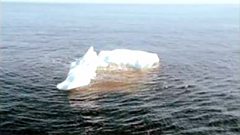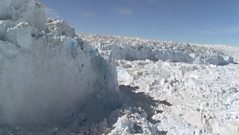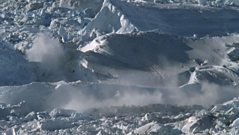
The Titanic iceberg starts life as a snowflake
The iceberg that sank Titanic started life as a snowflake 15,000 years earlier, compacting into solid ice before being broken up into bergs by melt water and the earth's inner heat.
The iceberg that sank Titanic started life as a snowflake 15,000 years earlier, compacting into solid ice before being broken up into bergs by melt water and the earth's inner heat.
Julian Dowdeswell of the Scott Polar Research Institute explains that the snow that falls at the centre of the Greenland ice sheet is at first fluffy and not particularly dense but compacts with depth to become a third of its original size.
Tens of metres below the surface it becomes so dense it turns to solid glacial ice. Bubbles become trapped within it. Each bubble holds captive a breath of its conception air, a record of the polar atmosphere that it will carry for 15,000 years. The rock solid ice transforms into icebergs due to the impact of melt water.
Through countless artic summers, melt water pools on the surface of the ice sheet before boring down into its heart. In some places the earth's inner heat warms the base of the ice sheet and the lowest layers of ice begin to melt, releasing the ice mass from the bedrock.
Ripped apart by the strains of movement crevasses open up - scars and weaknesses the iceberg would carry for the rest of its life. These huge streams of ice then proceed to slide down the Ilulissat drainage basin at speeds up to four miles a year. Under its own weight, it grinds up and absorbs elements of the bedrock, covering the last 200 miles to the coast in less than 50 years.
Duration:
This clip is from
Featured in...
![]()
The Iceberg That Sank the Titanic
Exploring the origins of the iceberg that caused the sinking of the Titanic.
More clips from The Iceberg That Sank the Titanic
-
![]()
What happened to the iceberg which sank the Titanic?
Duration: 01:30
-
![]()
The Titanic iceberg reaches the open ocean
Duration: 03:01
-
![]()
Origins of the Titanic iceberg
Duration: 02:46
-
![]()
The Titanic iceberg gets stuck
Duration: 03:22
More clips from Natural World
-
![]()
Robo Hare Vs Golden Eagle—2019-2020, Super Powered Eagles
Duration: 02:41
-
![]()
Super Powered Eagles—2019-2020, Super Powered Eagles
Duration: 01:15
-
![]()
Meet Tilly the golden eagle—2019-2020, Super Powered Eagles
Duration: 02:01










